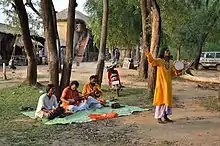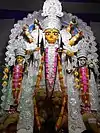Agamani-Vijaya
Agamani (Bengali: আগমনী গান Āgōmōni gān "Songs of advent") and Vijaya (বিজয়া গীতি Bījōyā gīţi "Songs of parting") are genres of Bengali folk songs celebrating the return of the Goddess Parvati to the home of her parents on the eve of the Bengali autumn festival of Durga Puja.[1][2] The Aagamani songs describe the return of Parvati to her home in rural Bengal, not as Goddess but as daughter, and are followed by Vijaya songs which describe the sorrow of separation three days later as Parvati returns to her husband Shiva.
| Music of West Bengal | |
|---|---|
 Baul Song Performing in Birbhum, West Bengal | |
| Genres | |
| |
| Specific forms | |
| Religious music | |
| Ethnic music | |
| Traditional music | |
| Media and performance | |
| Music media | Radio
Television Internet |
| Regional music | |
| Related areas | |
| Other regions | |
| Part of a series on the |
| Culture of Bengal |
|---|
 |
| History |
| Cuisine |
|
|
The folklore that give origin to the songs are the mythological stories of Goddess Parvati- daughter of the mighty King of the Himalayas- who marries Lord Shiva. Shiva is described in Hindu mythology as the ageless hermit who is also pauper, and as such personifies the poor husband with little interest in the bonds of family life. One night in autumn, Parvati's mother Goddess Menaka dreamt of her daughter as did Parvati of her mother. Menaka urged her husband to bring Parvati home, even if just for the festival, and Parvati agrees at her father's request to return for the three days of the festival.
See also
References
- Datta 2006, p. 95
- Bhowmik 2012
- Datta, Amaresh (2006), The Encyclopaedia Of Indian Literature Vol 1, Sahitya Akademi, ISBN 81-260-1803-8.
- Bhowmik, Dulal (2012), "Agamani-vijaya", in Islam, Sirajul; Jamal, Ahmed A. (eds.), Banglapedia: National Encyclopedia of Bangladesh (Second ed.), Asiatic Society of Bangladesh.
